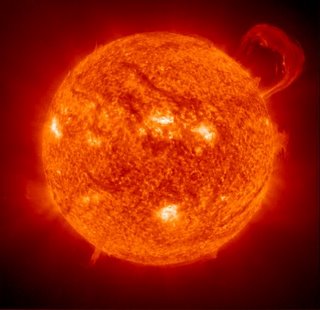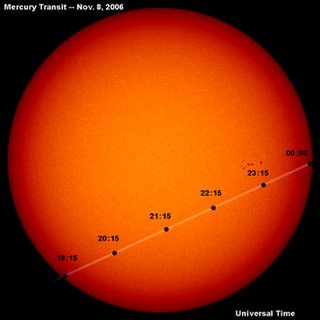Frivolous Friday
Fun with science edition.
I'm still on my geology/astronomy kick from when I took the kids to the local science museum. Check this stuff out.

A funky solar plume. Here are some sun facts. We are about 92.96 million miles from that giant fire ball. If the earth shifted a little either way we'd either be burnt toast ala Venus,

Yes that teeny tiny dot is a planet.
And as a nod to the fact that the SCOTUS is now hearing a global warming case I include this,
Why is the SCOTUS being asked to rule on a matter that should be left to scientists to fight over? Either you have solid data to back up your claims or don't. Don't go dragging the court into it. I may comment on some of the more hysterical claims made in this case later.
I'm still on my geology/astronomy kick from when I took the kids to the local science museum. Check this stuff out.

A funky solar plume. Here are some sun facts. We are about 92.96 million miles from that giant fire ball. If the earth shifted a little either way we'd either be burnt toast ala Venus,
It may be the least hospitable place for life in the solar system.or popsicle city ala Mars,
The pressure of Venus' atmosphere at the surface is 90 atmospheres (about the same as the pressure at a depth of 1 km in Earth's oceans). It is composed mostly of carbon dioxide. There are several layers of clouds many kilometers thick composed of sulfuric acid. These clouds completely obscure our view of the surface. This dense atmosphere produces a run-away greenhouse effect that raises Venus' surface temperature by about 400 degrees to over 740 K (hot enough to melt lead). Venus' surface is actually hotter than Mercury's despite being nearly twice as far from the Sun.
There are strong (350 kph) winds at the cloud tops but winds at the surface are very slow, no more than a few kilometers per hour.
Venus probably once had large amounts of water like Earth but it all boiled away. Venus is now quite dry. Earth would have suffered the same fate had it been just a little closer to the Sun."
"While the average temperature on Mars is about 218 K (-55 C, -67 F), Martian surface temperatures range widely from as little as 140 K (-133 C, -207 F) at the winter pole to almost 300 K (27 C, 80 F) on the day side during summer.Speaking of burnt toast here is the planet Mercury making a solar transit earlier this month.
Early in its history, Mars was much more like Earth. As with Earth almost all of its carbon dioxide was used up to form carbonate rocks. But lacking the Earth's plate tectonics, Mars is unable to recycle any of this carbon dioxide back into its atmosphere and so cannot sustain a significant greenhouse effect. The surface of Mars is therefore much colder than the Earth would be at that distance from the Sun."

Yes that teeny tiny dot is a planet.
And as a nod to the fact that the SCOTUS is now hearing a global warming case I include this,
"The Earth's atmosphere is 77% nitrogen, 21% oxygen, with traces of argon, carbon dioxide and water. There was probably a very much larger amount of carbon dioxide in the Earth's atmosphere when the Earth was first formed, but it has since been almost all incorporated into carbonate rocks and to a lesser extent dissolved into the oceans and consumed by living plants. Plate tectonics and biological processes now maintain a continual flow of carbon dioxide from the atmosphere to these various "sinks" and back again. The tiny amount of carbon dioxide resident in the atmosphere at any time is extremely important to the maintenance of the Earth's surface temperature via the greenhouse effect. The greenhouse effect raises the average surface temperature about 35 degrees C above what it would otherwise be (from a frigid -21 C to a comfortable +14 C); without it the oceans would freeze and life as we know it would be impossible. (Water vapor is also an important greenhouse gas.)"At the bottom of the page under the heading Open Issues is the question, "How much more carbon dioxide can we dump into the Earth's atmosphere before it ends up like Venus?" Well, seeing as how there are only trace amounts to begin with (despite our affection for fossil fuels) and there are natural sinks that make use of that trace amount (like every photosynthesizing organism on the planet) and Venus' atmosphere is mostly carbon dioxide rather than the trace found on earth I'd say we could only manage it by blowing the planet to bits.
Why is the SCOTUS being asked to rule on a matter that should be left to scientists to fight over? Either you have solid data to back up your claims or don't. Don't go dragging the court into it. I may comment on some of the more hysterical claims made in this case later.


Earlier this month, I got my new issue of National Geographics (yeah, I know, --- Nerd!) Anyway, there was an amazing map of the solar system, which included the new "dwarf planet" of Pluto, (downgraded from planet this year Ceres, and Eris. Quite interesting.
ReplyDeleteThe size of Jupiter, and Saturn are amazing. While Earth is 7.9k miles around, Saturn is 74.8K miles, and Jupiter is colossal 88.8k miles around.
Along with that the drawing showed that along with Saturn, Jupiter, Uranus, and Neptune also have rings!
I haven't been keeping up for a while, but Who Knew!
Cool.
A for SCOTUS... Let's pray for the best..